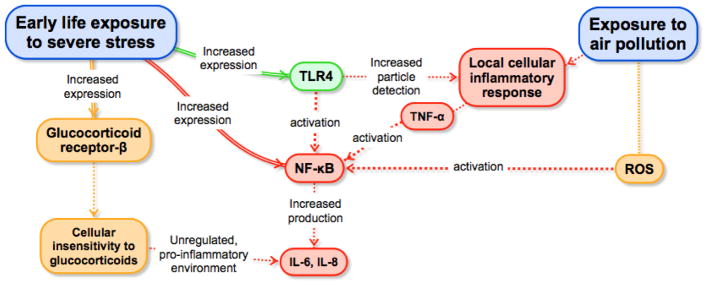Fig. 1.
An integrated multi-level model of early life stress, air pollution, and health. Depicted are the mechanisms through which early life stress exposure may affect the inflammatory response to air pollution exposure, leading in turn to poor lifespan health. Early life exposure to severe stress increases the expression of toll-like receptor 4 (TLR4), glucocorticoid receptor-β, and nuclear factor (NF)-κB (Bennett et al., 2012; Fiordelisi et al., 2017) (G. E. Miller et al., 2009). TLR4 is part of the air pollution recognition process that leads to the production of tumor necrosis factor alpha (TNF-α) and culminates in the activation of NF-κB (Kampfrath et al., 2011) (Kawai and Akira, 2007; Lund et al., 2011)(Becker et al., 2002; Shoenfelt et al., 2009). Exposure to air pollution increases reactive oxygen species (ROS) generation in the heart and lung (Gurgueira et al., 2002), which in turn also activates NF-κB. Activation of NF-κB upregulates the expression of genes coding for cytokines, chemokines, and other pro-inflammatory mediators such as interleukin-6 (IL-6) and interleukin-8 (IL-8) (Gurgueira et al., 2002)(Bennett et al., 2012). Finally, increased expression of glucocorticoid receptor- β leads to insensitivity to glucocorticoids that creates a pro-inflammatory environment, which culminates in increased production of IL-6 and IL-8 (Cain and Cidlowski, 2015; Hamid et al., 1999).

